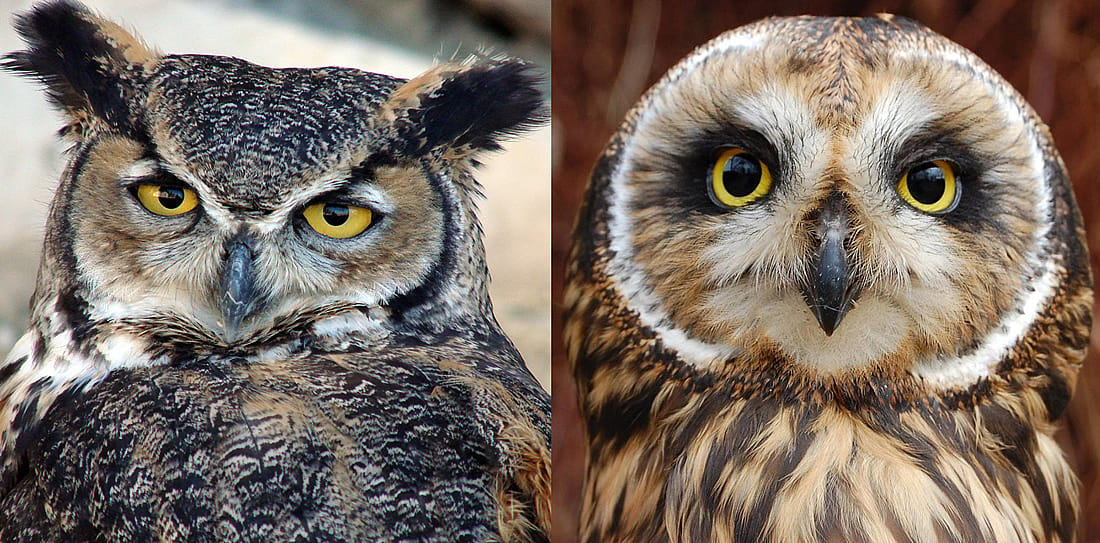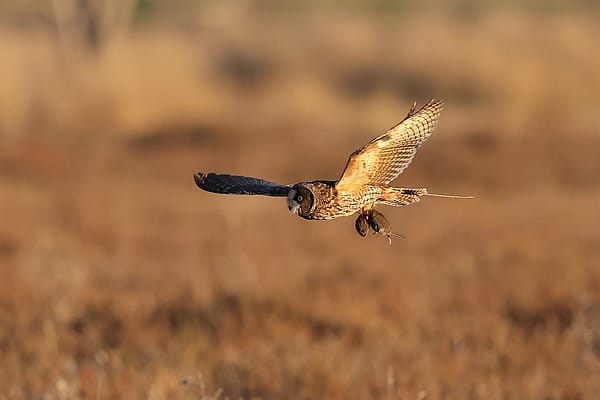
Northern Harriers: The Hawks That Resemble Owls

How Northern Harriers are Similar to Owls
A Northern Harrier flies low over the grasslands with a flock of Red-winged Blackbirds following it. Commonly mobbed by blackbirds, sparrows, starlings, swallows, kestrels, Short-eared Owls, Sharp-shinned Hawks, and other birds, the raptor decides the annoying harassers are too swift and maneuverable to put out the effort of trying to catch one.
For more information on mobbing check out my blog
What It Is, and Why Do Mobbed Birds Put Up With It.
https://centerofthewest.org/2019/01/21/mobbing-what-it-is-why-birds-dont-defend-themselves/
Is it a hawk? Is it an owl? Short-eared Owls and Northern Harriers often share hunting and nesting territories, competing and even fighting over prey. Sometimes they will even steal from each other, a behavior known as kleptoparasitism.
For more information on kleptoparasites check out my blog Kleptoparasites: Pirates in the World of Birds.
https://centerofthewest.org/2019/03/25/kleptoparasites-pirates-world-birds

It’s the Face
Northern Harriers are the most owl-like of all hawks. Both owls and Northern Harriers have a parentheses-like mark, or ring, around their face known as a facial disc. Look at the two photos above. You can see that Teasdale sports a black facial disc, while Amelia’s face is enhanced by a white disc. These facial discs are made up of stiff feathers that can be raised to direct sound into their ears. In the photo below, notice the facial disc of a Northern Harrier.
It’s the Hunt
Owls and harriers rely on hearing and vision when hunting. With their disc-shaped face directing sound to their ears, they are able to locate prey with hearing alone. Harriers and many owls can be observed gliding low over open country. Sometimes hovering for a brief moment, they may look and listen for prey moving in the vegetation below. When a potential meal is spotted or heard they will drop down, talons extended, to seize the prey.
While many owls are nocturnal, preferring to hunt at night, both Northern Harriers and Short-eared Owls usually hunt during the day. Like owls, harriers are also capable of hunting in low light.

How to Identify a Northern Harrier
Looking through your binoculars, you see a pair of harriers gliding low over the prairie, often teetering from side to side similar to a Turkey Vulture. A flash of a solid white rump band is a distinguishing feature. With long yet narrow wings and long tails, their body shape helps to identify the hawk as a Northern Harrier. One harrier is pearl gray above and white below with black wing tips. The other is dark brown above and a washed rufous or buff color with dark streaking below. All Northern Harriers have a white rump patch. What does the different plumage color tell us? The white and gray harrier is the male, while the brown and rufous one is the female.
Juveniles are often miss-identified as females since young harriers of both sexes are very similar in color to female harriers. Females and juveniles are brown above with brown heads. Juveniles differ with darker rufous or cinnamon underparts and no, or only faint streaking on the chest. Confusing? Sometimes only an expert will know for sure. If you are lucky enough to get a good look at the eyes, the mystery may be solved for you. Juvenile males have pale greenish-yellow eyes, while juvenile females have dark chocolate brown eyes. As adults, both will have a lemon-yellow eye color.
Watch this short 2:46 minute video for a close up look at some of the identifying features of Northern Harriers.
https://www.youtube.com/watch?v=IYcS_vlXNo0
10 Quick Interesting Harrier Facts
- Harriers nest on the ground. Though males do return to the same territory, they do not reuse a nest, nor do they mate for life.
- If a male fails to display enough to please the female, or doesn’t provide sufficient food, the female may abandon their mate during courting or nest building.
- Males may be monogamous or polygamous. Usually the males will have one or two mates. Depending on the resource you read, however, it is believed they may have as many as five to seven. Of the birds living at the Draper Museum Raptor Experience, only the Eastern Screech-owl is sometimes polygamous. Generally, one male pairs with one female. Eastern Screech-owl males, however, may breed with and care for two females.
- Northern Harriers hunt almost entirely on the wing. Hunting mostly small mammals and birds, they also dine on insects, amphibians, and reptiles. Sometimes they will prey on larger animals such as cottontail rabbits and ducks.
- Harriers sometimes kill larger animals by drowning them. Small birds may be grabbed right out of the air.
- A male Northern Harrier is sometimes called a “Gray Ghost.”
- Females may weigh as much as 50% more than the males.
- In the winter, Northern Harriers roost communally on the ground, often together with Short-eared Owls.
- Like Peregrine Falcons, when Northern Harriers consumed prey containing the now outlawed DDT, the pesticide reduced productivity by causing eggshell thinning.
- Northern Harrier fossils discovered in northern Mexico have been dated back 11,000 to 40,000 years.
Northern Harriers live across most of North America. Ranging from Alaska to Mexico and most of Central America. So keep your eyes peeled and maybe you’ll spot a Gray Ghost or other harrier as it glides over the open countryside.
Photo Credits:
Male Harrier in Flight by Tony’s Takes, Attribution-NonCommercial-NoDerivs 2.0 Generic License
Great Horned Owl Teasdale and Short-eared Owl Amelia. Teasdale by author Anne Hay, https://www.flickr.com/photos/157982666@N07/, Amelia from the Draper Museum Raptor Experience Facebook page, https://www.facebook.com/pg/DraperMuseumRaptorExperience/posts/?ref=notif
Head shot of Northern Harrier by Mick Thompson, Attribution-NonCommercial 2.0 Generic License
Short-eared Owl Hunting by James West, Attribution-NonCommercial-NoDerivs 2.0 Generic License
Northern Harrier hovering low over the ground by Mick Thompson, Attribution-NonCommercial 2.0 Generic License
Female Harrier by Tony’s Takes, Attribution-NonCommercial-NoDerivs 2.0 Generic License
Male Harrier in Glide – Under Wing View by Tony’s Takes, Attribution-NonCommercial-NoDerivs 2.0 Generic License
Harrier Chicks by Robert Pruner, Attribution-NonCommercial-NoDerivs 2.0 Generic License
Male Harrier Hunting Low Over a Winter Field, Tony;s Takes, NonCommercial-NoDerivs 2.0 Generic License
Written By
Anne Hay
Anne Hay has a Bachelor's degree in Elementary Education and a Master's in Computers in Education. She spent most of her working years teaching third grade at Livingston School in Cody, Wyoming. After retiring she began doing a variety of volunteer work for the Buffalo Bill Center of the West’s Draper Natural History Museum. Anne loves nature and has a concern for the environment. She believes that educating the public, so that they will have a better understanding and appreciation for the natural world, is very important. Because of this belief, volunteering at the Center is a perfect fit. She spends time in the Draper Lab, observing eagle nests for Dr. Charles Preston’s long-term research project on nesting golden eagles, writing observation reports of raptor sightings in the Bighorn Basin, and working with the Draper Museum Raptor Experience. Anne states that, “Having a bird on my glove, is one of my all time favorite things in life.”

















